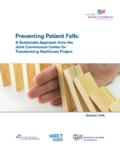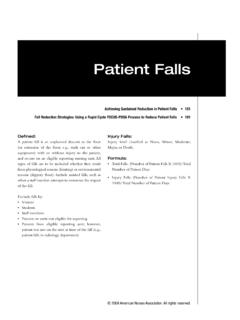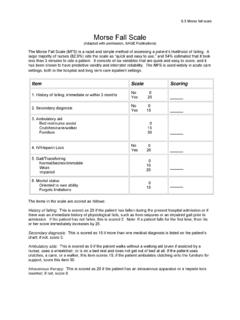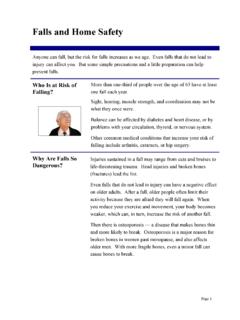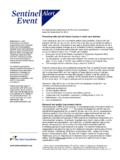Transcription of Falls Prevention Strategies & Interventions
1 Falls Prevention Strategies & Interventions (Submitted by Kentucky s Office of Inspector General) EQUIPMENT Alarms Sensor Alarms Floor sensor alarm Chair alarms Bed alarms Bath room alarms Pressure alarms Motion sensor alarms set to allow resident to turn in bed; alarm sounds upon motion associated with getting up from bed or chair. Alarm can be equipped with voice message to Please lie down; you are at risk for fall . Call for assistance has been made. Personal alarm Appropriate alarms Voice-activated alarms Clip and pressure alarms Use of alarms; tab, mat, laser Use alarms as appropriate Bed/chair alarm on which family can record message.
2 Mom, don t get up until someone is there to help you. (This worked really well for us.) Sensor pads in bed and chair Motion sensor Hipsters Low bed Electric low bed Mats fall mats Mats on floors Mats on floor at bedside Low bed with mats Low bed with mat at bedside Low beds/mats as appropriate Non-skid Items Non-skid strips on floor by bed and in bathroom Non-skid strips in bath Velcro seat belt Use Velcro in chair to assist resident from sliding down in the chair Walker or wheelchair Non-tip wheelchair Correct devices with appropriate size (walker/wheelchair) Transfer Assistive Devices Ensure staff uses gait belt Transfer resident with gait belt Pull-up pole-pole that runs floor to ceiling, placed by bed/chair, provides assist Transfer poles-Resident can grab, provides stability for rising or transfer Mattresses/Bedding Winged mattress Better quality mattresses Concave mattress cover Perimeter mattress Use Dycem mats to prevent residents from sliding out of wheelchairs, and from sliding down in bed when HOB is up.
3 Dycem in chair Better quality sheets (high thread count) Bed warmers Down blankets 2 Use Stop signs to prevent awaking resident Roll guards Reacher Nonswivel chairs/lazy susan type things that might be used for leaning Lift chairs, if able to use Use mechanical lifts when needed Non-traditional call lights Increase wattage of light bulbs if safe to do so in room STAFF ACTIONS Information gathering Check blood sugars Check blood pressure-lying and standing, to see if resident has orthostatic hypotension Medication review Check on-going use of hypnotics. If use is on-going, investigate depression/pain factor Review meds with consulting pharmacist for polypharmacy, which may have side effects causing Falls Monitor appropriate labs Pharmacy/pharmacist review of medications Is there a need for medication adjustments Have recent adjustments been made that could be contributing to Falls Evaluate medication regimen for new meds side effects that could be problematic Check labs for changes.
4 Check for accurate reconciliation of noted concerns What caused the fall ? Assessed for side rails Evaluate ambulation/gait Read history of ambulation and transfer Monitor patient s gait Use information in daily routine Eyeglasses Check/clean glasses Eye exam Make sure glasses are worn daily Wear glasses during ambulation Have PT screen after fall , if not isolated Assess for basic needs hunger, pain, toileting Toileting Evaluate need to offer additional opportunities for toileting Respond to individual toileting needs Incontinency evaluation Scheduled toileting Increase toileting plans as appropriate; review staffing schedule to determine adequate to carry out toileting plans Toilet every two hours or less Prompted toileting Toilet before and after meals, and at bedtime Toileting program offered to residents with reoccurring Falls Review investigation and implementation of Interventions and evaluation look at what the surveyor reviews Devices determining if devices are restraints Occupational Therapy (OT) patient screens Is the resident experiencing pain?
5 Interview patient and family Therapy screen/evaluation Track/trend the Falls -may give insight into what is going on Educate staff on Interventions Patient referral Get rid of over-the-bed tables when not is use 3 Staff education and supervision Educate staff about slippery floors Adequate staff supervision Specify what supervision is needed; do not just write provide supervision Educate staff Assist with ambulation Reeducate resident if alert and oriented Call light education/reminders Ambulation Care plan Therapy/strengthening Provide restorative and follow up on effectiveness Ambulate when attempting to get out of wheelchair Ask if resident is tired and have resident lie down Reposition residents who are in wheelchair Try getting resident out of bed safely, then provide food, fluids, and company.
6 Resident might comply with care better with one nursing assistant than another (bath) Answer call bells promptly. Don t say, I ll be there in a minute and not go back ( Falls , incontinence can occur) Don t say, I just took you five minutes ago. Family assistance Keep in sight close by for interaction Have all departments get involved in Falls Prevention Ambulation schedule RESIDENT ACTIVITIES Activities, activities, activities Walking with assist to dine/activities at certain times related to Falls Individualized activities Activities provided at appropriate cognitive level Activities for residents used to waking during the 11-7 shift, and who are up during the night. Sit resident at nurses desk ?
7 ?? Therapy Involve, encourage, re-invite to activities Offer activities of past and present interest If resident continually tries to get up offer to walk them Example: Resident has retired from desk job, and is a frequent faller, anxious, and medicated without successful outcome. The nursing home created a fake bank check book so he could make out checks. This worked and kept him busy. For residents who cannot sit still: Offer a doll (soft body, weight with bean bag) or stuffed animal to nurture Purse/Bag with zipper Put safe objects inside. Remove the pull from zipper. Residents can arrange items. Redirection use their personal history to devise plans Planned walks to meet motion needs Hour of Sleep bathing/backrubs to aid sleep Music Sing to (or with) resident Turkey/milk at hour of sleep for snack (Turkey does have the makings of a natural sedative in it, an amino acid called tryptophan.)
8 Tryptophan is an essential amino acid, meaning that the body can't manufacture it. The body has to get tryptophan and other essential amino acids from food. Tryptophan helps the body produce the B-vitamin niacin, which, in turn, helps the body produce serotonin, a remarkable chemical that acts as a calming agent in the brain and plays a key role in sleep.) Plant therapy Pet therapy lap cat or dog Offer daily exercise program to increase flexibility and strengthening Body Recall for seniors Start a walking club. Measure hallways/courtyard, then make a challenge chart. Reward meeting goals Keep items in easy reach Lower voice, speak softly and calmly 4 ENVIRONMENT Keep area free from clutter Remove clutter from rooms and public areas Arrange room to have clear passage-ways.
9 (Clear path from bed to bathroom to chair, etc.) Keep environment free of hazards Decrease noise Slow, soft music or white noise (waterfall) Noise reduction at night Decrease traffic in hallways Proper lighting for resident s toileting Nightlights in bathrooms Night lighting Aromatherapy Bolster pillows and wedges. Residents used to bigger beds and partner can use bolster to hug Set the tone for sleep Secured curtains out of resident s reach Keep frequently used items (phone, remote control) close Rearrange resident room Label bathroom door In bathroom, paint walls a slightly darker color so white toilet is easier to see Use non-glare wax on floors Mix sand with floor wax, cover high-traffic areas of resident s room PERSONAL Properly fitting shoes Non-skid shoes Provide proper footwear.
10 No slip-ons (with the backs out) and no shoes with slick soles Non-skid socks Do not walk around in socks Encourage use of gowns instead of pajamas (Some residents get tangled up in their pajama bottoms when they go to the bathroom) Bathing prior to bed Lavender lotion Soft massage 5 Falls Prevention Strategies & Interventions Submitted by Kentucky Association of Health Care Facilities EQUIPMENT/ENVIRONMENT Rearrange room to make better pathways to meet residents needs (like bathroom) Change room mates to one with less medical equipment or "stuff" (clutter) Move personal items closer Relocate to room closer to nurses station Add verbal warning alarm using the resident's or family members voice.
